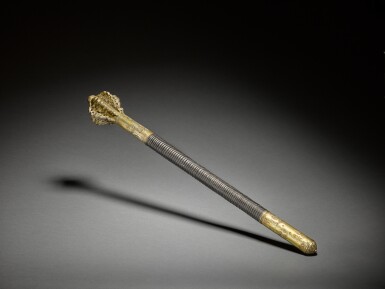
An Ottoman gilt flanged mace, Turkey, third quarter 17th century
Estimate
30,000 - 50,000 GBP
Lot Details
Description
the wooden mace with head and mounts silvered and gilded over a ferrous core and decorated with chased tulip motifs, the haft wrapped with ribbed leather, the head with seven openwork flanges
62.5cm.
The present mace is part of a small group of seventeenth-century Ottoman maces characterised by their silvered and gilded mounts and openwork flanges. One is in the Karlruher Türkenbeute (inv. no.D 242), where it was first recorded in an inventory dated 1691 (Petrasch et al. 1991, pp.210-211). Petrasch et al. record two other maces of this form, of which one is now in the Five Continents Museum, Munich (inv. no.26-N-103), while the other was first recorded in the Türkenbeute of Hermann Philipp von Oer (1644-1703) of 1685 and is now in a private collection. Four further maces from this group are in the Metropolitan Museum of Art (inv. no. 6.25.2958, Alexander 2015, p 242); the Khalili Collection (inv. no.MTW 1129; Alexander 1992, p.118); Wilanów Palace (inv. no.509; Kangal (ed.), 1999, pp.174-5), and the Hermitage Museum, St Petersburg (inv. no.V.O.-1697; Obraztsov 2021, p.86), the latter from the early twentieth-century collection of Sergey Sheremetev.
The decorative repertoire of on the mounts is comparable to a fine silver-gilt penbox sold in these rooms, 9 April 2014, lot 160, and now in the Islamic Arts Museum Malaysia (inv. no.2014.5.24; Barakat et al. 2023, pp.207), which bears the tughra of Mehmed IV (r.1648-87). As on that penbox, the smooth surface forms a ground for chased tulip motifs themselves worked with simple but elegant floral patterns.
You May Also Like






![An extremely rare illustrated manuscript of the Ka'banameh (A history of the Ka'ba) by Abdulrahman Gubari (d.1566), signed by Ahmad [...] al-Khatib, Kaposvár, Hungary, dated Dhu'l-Hijjah 1080 AH/April-May 1670 AD](https://dam.sothebys.com/dam/image/lot/1e33ac28-a449-4673-a23f-f1ca4d5a13b3/primary/extra_small)



